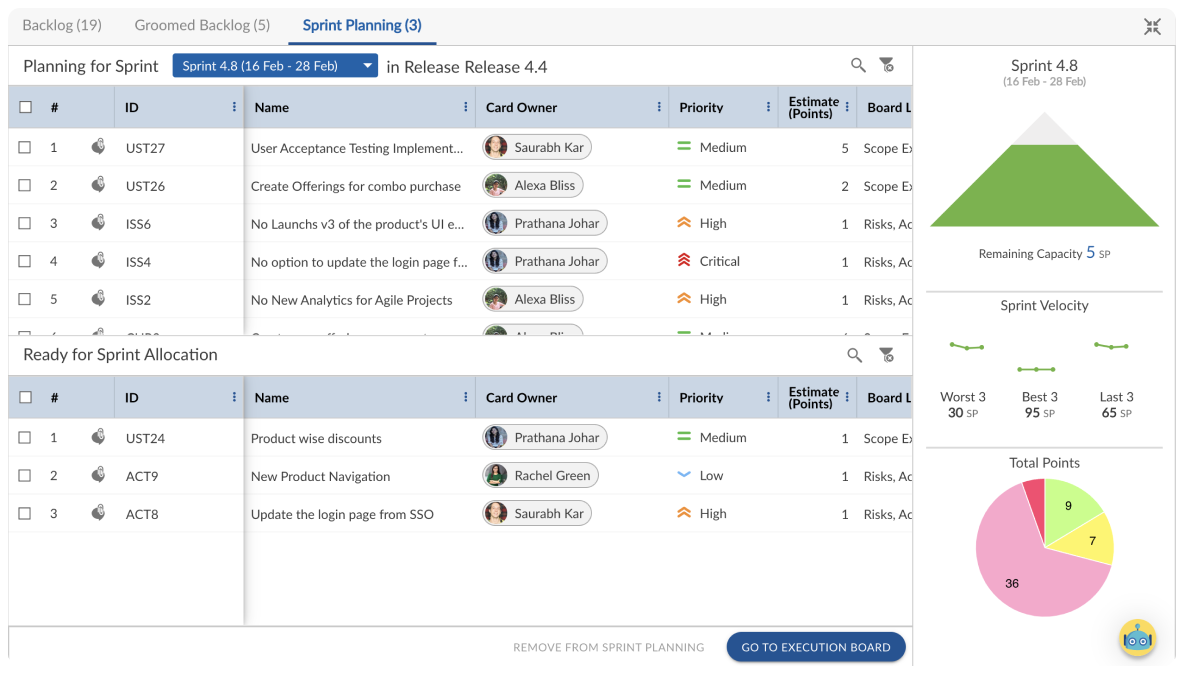Scrum Methodology Explained: An Introduction for Agile Teams
- 11 mins read
-
By Bhaskar S
- Updated on July 9, 2024
Navigate to
What is Scrum?
Scrum is a widely used framework for managing complex projects, particularly in the realm of software development. At its core, Scrum promotes a collaborative approach to work, emphasizing teamwork, transparency, and adaptability. Unlike traditional project management methods that rely on detailed upfront planning, Scrum operates on the principle of iteration and continuous improvement.
In Scrum, work is organized into short iterations known as “sprints,” typically lasting one to four weeks. During each sprint, the team focuses on delivering a small, tangible piece of the overall project, known as an increment. Regular meetings, such as daily stand-ups and sprint reviews, keep the team aligned and ensure progress is on track. By breaking the work into manageable chunks and prioritizing flexibility and responsiveness, Scrum enables teams to adapt quickly to changing requirements and deliver high-quality products efficiently.
At its heart, Scrum aims to fulfill customer needs through transparent communication, shared responsibility, and a commitment to ongoing improvement. Beginning with a high-level project concept, it refines this vision into a prioritized list of features (known as the product backlog) that align with the product owner’s objectives. This agile approach has become a cornerstone in the world of software development, driving innovation and customer satisfaction.
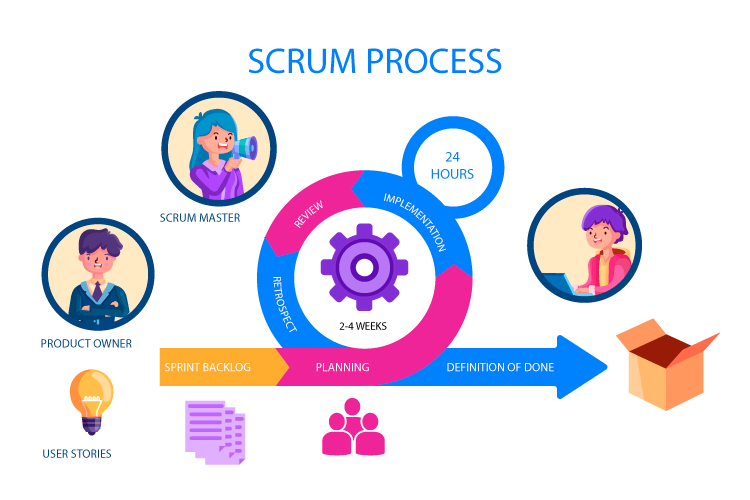
Learn Scrum:
A brief History on Scrum
The history of Scrum can be traced back to 1986 in the Harvard Business Review (HBR) article titled, “The New Product Development Game” by Hirotaka Takeuchi & Ikujiro Nonaka. This article describes how companies such as Honda, Canon, and Fuji-Xerox produce new products worldwide using a scalable and team-based approach to product development. This approach emphasizes the importance of empowering self-organized teams.

In 1993, Jeff Sutherland and his team at Easel Corporation created the Scrum process to be used in software development processes by combining the concepts of the 1986 article with the concepts of object-oriented development, empirical process control, iterative development and incremental, software processes and productivity improvement, as well as the development of complex and dynamic systems.
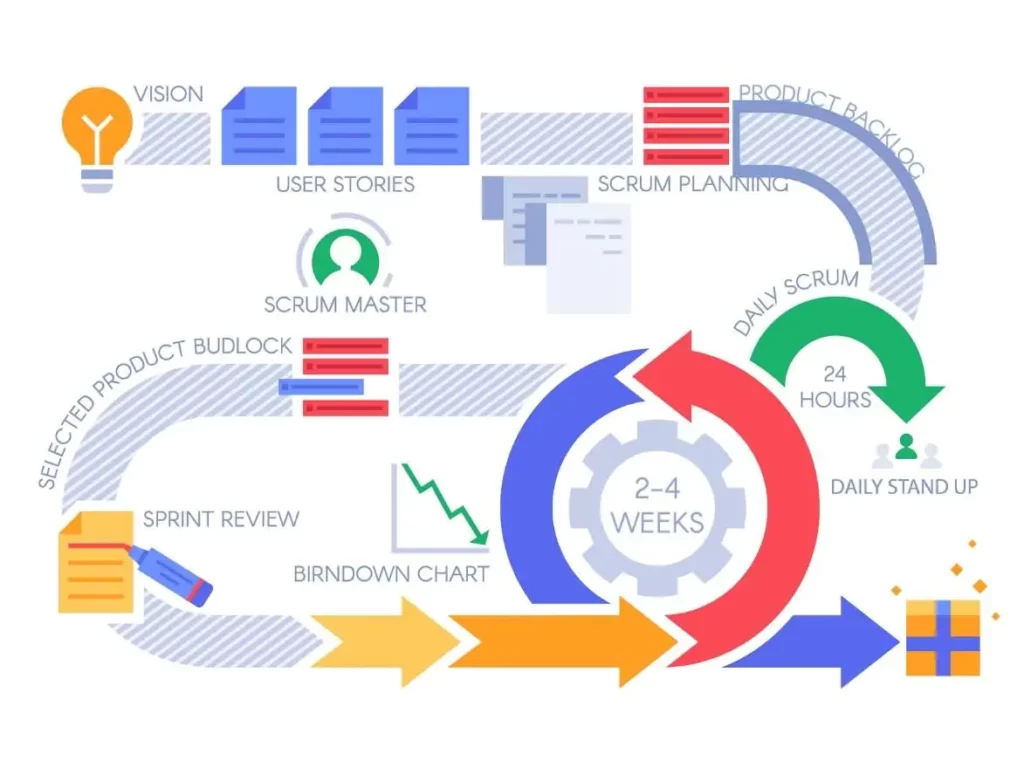
Scrum Methodology & Process
Scrum is precisely an evolution of Agile Management. Scrum methodology is based on a set of very defined practices and roles that must be involved during the software development process. It is a flexible methodology that rewards the application of the 12 agile principles in a context agreed by all the team members of the product.
Scrum is executed in temporary blocks that are short and periodic, called Sprints, which usually range from 2 to 4 weeks, which is the term for feedback and reflection. Each Sprint is an entity in itself, that is, it provides a complete result, a variation of the final product that must be able to be delivered to the client with the least possible effort when requested.
The process has as a starting point, a list of objectives/ requirements that make up the project plan. It is the client of the project that prioritizes these objectives considering a balance of the value and the cost thereof, that is how the iterations and consequent deliveries are determined.
On the one hand the market demands quality, fast delivery at lower costs, for which a company must be very agile and flexible in the development of products, to achieve short development cycles that can meet the demand of customers without undermining the quality of the result. It is a very easy methodology to implement and very popular for the quick results it gets.
Scrum methodology is used mainly for software development, but other sectors are also taking advantage of its benefits by implementing this methodology in their organizational models such as sales, marketing, & HR teams, etc.
Nimble Agile offers specialized Scrum features, so teams can optimize their Sprint planning and execution. Nimble facilitates efficient backlog management, task allocation, and progress monitoring, streamlining the management of each Sprint.
Different Roles in Scrum
“Doing half of something is, essentially, doing nothing.”
Jeff Sutherland Tweet
The Scrum team consists of the following roles:
Product owner (PO)
Is the representative of the stakeholders and customers who use the software. They focus on the business part and is responsible for the ROI of the project. They Translate the vision of the project to the team, validate the benefits in stories to be incorporated into the Product Backlog and prioritize them on a regular basis.
Scrum master
The person who leads the team guiding them to comply with the rules and processes of the methodology. Scrum master manages the reduction of impediments of the project and works with the Product Owner to maximize the ROI. The Scrum Master is in charge of keeping Scrum up to date, providing coaching, mentoring and training to the teams in case it needs it.
“It is the Scrum Master’s job to guide the team toward continuous improvement – to ask with regularity, “How can we do what we do better?”
Jeff Sutherland Tweet
Scrum Team
A group of professionals with the necessary technical knowledge who develop the project jointly carrying out the stories they commit to at the start of each sprint.
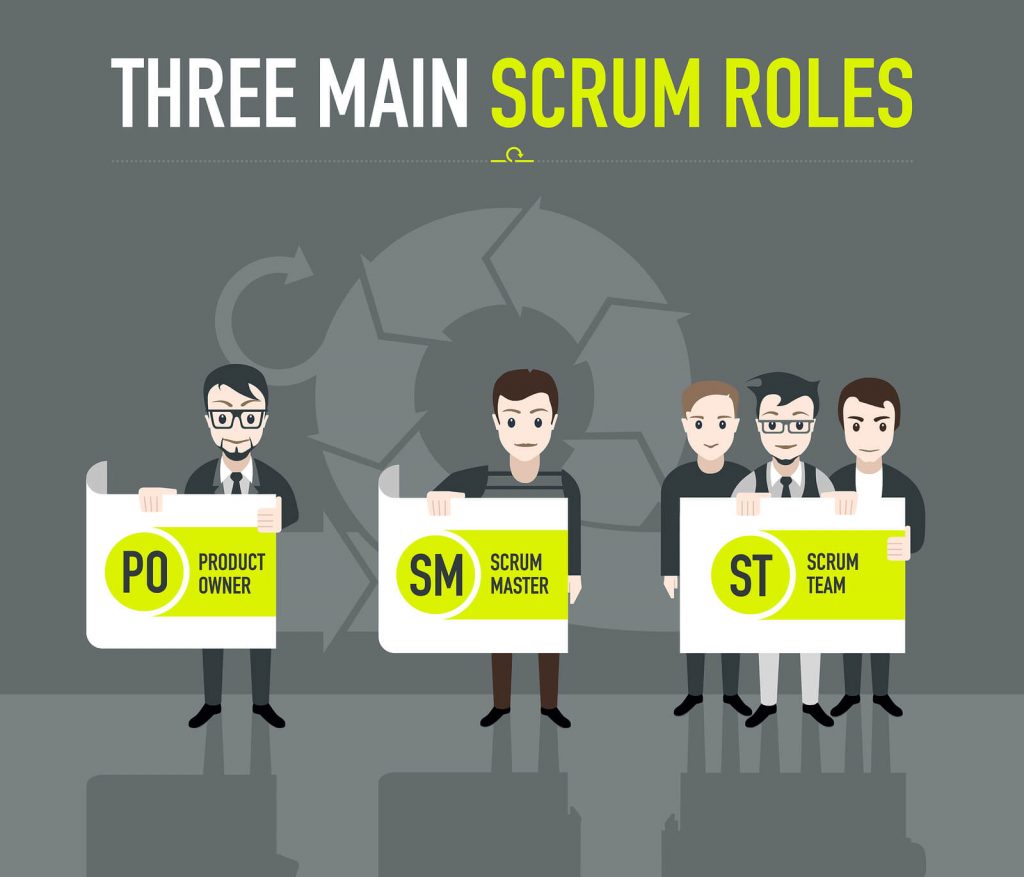
Benefits of Scrum Methodology
Scrum has many advantages over other agile development methodologies. It is currently the most used and trusted framework of reference in the software industry. Below are some of the known benefits of Scrum:
Easily Scalable: Scrum processes are iterative and are handled within specific work periods, which makes it easier for the team to focus on definite functionalities for each period. This not only has the benefit of achieving better deliverables in line with the needs of the user, but also gives the ability to the teams to scale the modules in terms of functionality, design, scope and characteristics in an orderly, transparent and simple manner.
Compliance of expectations: The client establishes their expectations indicating the value that each requirement/ history of the project brings, the team estimates them and with this information the Product Owner establishes its priority. On a regular basis, in the sprint demos, the Product Owner verifies that the requirements have been met and transmits feedback to the team.
Flexible to changes: Quick reaction to changes in requirements generated by customer needs or market developments. The methodology is designed to adapt to the changing requirements that complex projects entail.
Time to Market reduction: The client can start using the most important functionalities of the project before the product is completely ready.
Higher software quality: The working method and the need to obtain a functional version after each iteration, helps to obtain a higher quality software.
Timely Prediction: Using this methodology, we know the average speed of the team by sprint (story points), with which, consequently, it is possible to estimate when a certain functionality that is still in the backlog will be available.
Reduction of risks: The fact of carrying out the most valuable functionalities in the first place and of knowing the speed with which the team advances in the project, allows to clear risks effectively in advance.
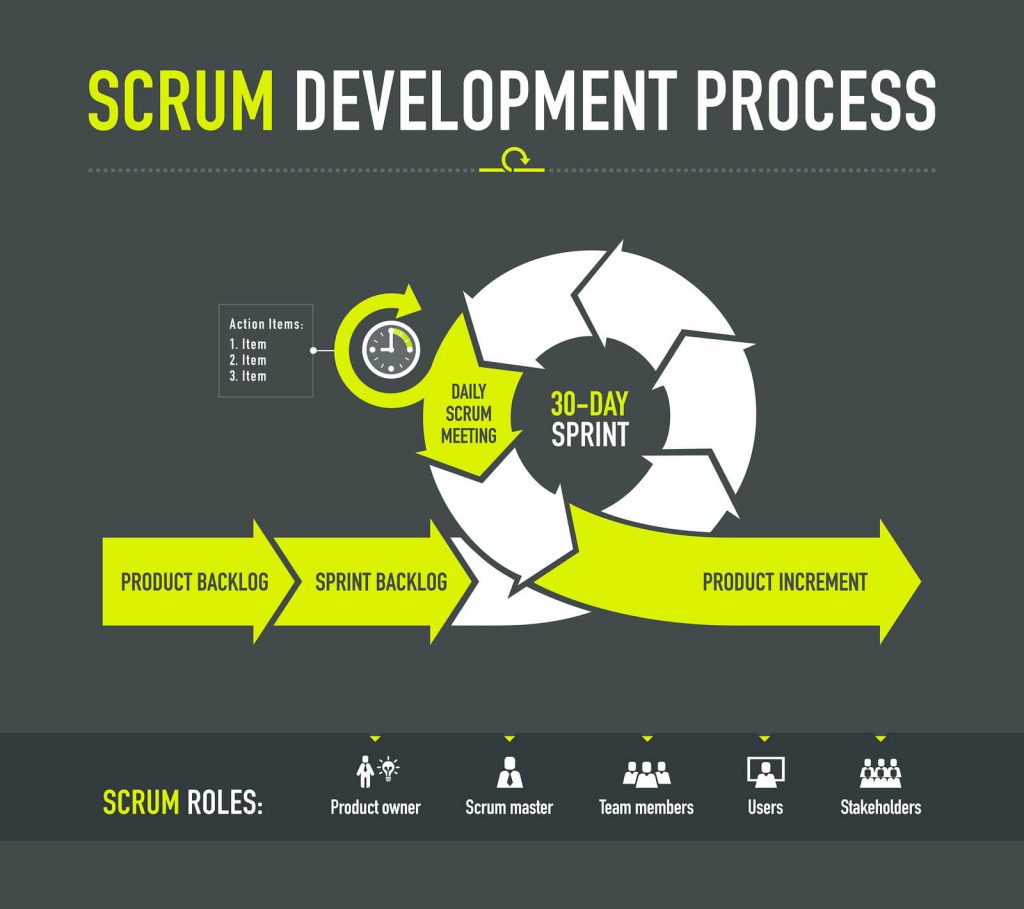
Scrum Ceremonies/ Events
In the world of Scrum, ceremonies, often referred to as events, are integral components that structure the work process. These meticulously planned gatherings serve as key waypoints throughout the project’s journey, promoting collaboration, transparency, and effectiveness. Let’s delve into what Scrum ceremonies are, their significance, and the core events that shape the Scrum framework:
Defining Scrum Ceremonies:
Scrum ceremonies, in essence, are pre-defined meetings or events held at specific times during a Sprint, which is a time-boxed iteration of work. These events provide various opportunities for the Scrum Team to inspect progress, adapt strategies, and ensure that the product is on the right track to meet the Sprint Goal. Scrum ceremonies are designed to be brief but effective, fostering open communication, alignment, and continuous improvement.
How Scrum Ceremonies Help:
👉 Fostering Collaboration: By bringing the Scrum Team and stakeholders together, Scrum ceremonies create an environment for effective collaboration. They offer designated spaces for discussions, decision-making, and problem-solving.
👉 Ensuring Transparency: Scrum values transparency, and ceremonies are the stages where transparency is realized. They make the progress and challenges visible to all stakeholders, thereby aligning everyone with the project’s status.
👉 Adhering to Time-Boxing: Each ceremony has a defined duration, ensuring that discussions and planning don’t drag on endlessly. This time-boxing enforces discipline and punctuality.
👉 Inspecting and Adapting: Scrum ceremonies are all about inspecting the work done, collecting feedback, and adapting plans and processes accordingly. They support a culture of continuous improvement.
Core Scrum Ceremonies:
Sprint Planning: At the beginning of each Sprint, the Scrum Team conducts a Sprint Planning meeting. This event focuses on setting the Sprint Goal and selecting items from the Product Backlog to work on during the Sprint.
Daily Scrum: The Daily Scrum, or Daily Standup, is a brief, daily event where the Development Team synchronizes its activities. Each member shares what they’ve worked on, what they plan to do, and any impediments they’re facing.
Sprint Review: After the Sprint, the Scrum Team holds a Sprint Review to showcase the work completed during the Sprint. Stakeholders provide feedback, and the Product Backlog is adjusted as needed.
Sprint Retrospective: The Sprint Retrospective takes place after the Sprint Review and is a reflective event. The Scrum Team inspects its processes and identifies improvements for the next Sprint.
Backlog Refinement: While not an official ceremony, Backlog Refinement involves regularly refining and clarifying the Product Backlog to prepare items for future Sprints.
Scrum ceremonies are the rhythmic heartbeats of the Scrum framework. They encourage collaboration, maintain transparency, and facilitate the essential processes of planning, inspecting, and adapting. By adhering to these ceremonies, the Scrum Team harnesses the power of structured events to deliver high-quality products and continuously enhance their performance.
Scrum Artifacts
Scrum Artifacts are designed to guarantee the transparency of key information in decision making.
Product Backlog (PB): The product backlog is a list that collects everything the product needs to satisfy the potential customers. It is prepared by the product owner and the functions are prioritized according to what is more and less important for the business. The goal is for the product owner to answer the question “What should be done”.
Sprint Backlog (SB): It is a subset of items of the product backlog, which are selected by the team to perform during the sprint on which they are going to work. The team establishes the duration of each Sprint. Usually the sprint backlog, is displayed on physical boards called as Scrum board – that makes the development process visible to everyone who enters the development area.
Increment: The Increment is the sum of all the tasks, use cases, user stories, product backlogs and any element that was developed during the sprint and that will be made available to the end user in the form of Software.
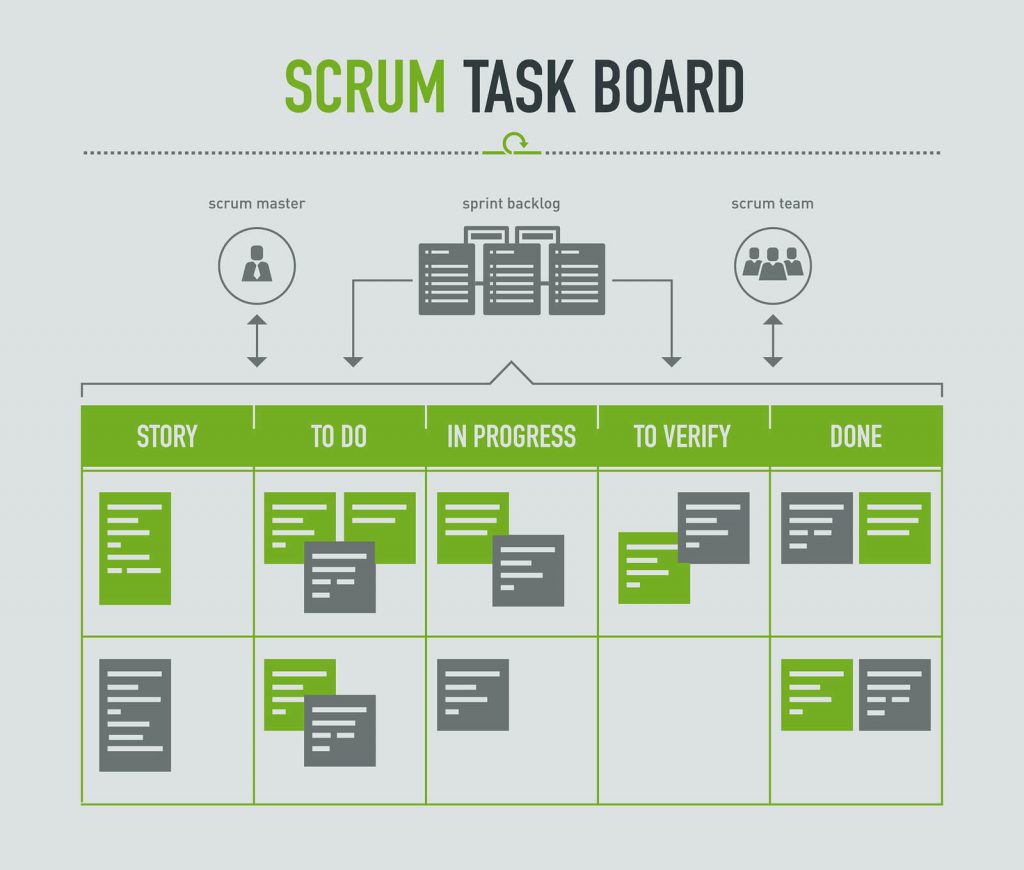
Planning in Scrum
The Sprint Planning Meeting is held at the beginning of each Sprint. All the members of the Team participate in the meeting, i.e., the Product Owner, Scrum Master and all the Development Team. The entire Scrum team must understand and define what objective should be obtained in that Sprint (Sprint Goal). From this point the development team must design a work plan to achieve the objective. This planning should allow you to see if the sprint goal involves a workload according to the duration stipulated for the Sprints (which is 2 to 4 weeks).
The client shows the result to be achieved in that Sprint and the requirements of the deliverable product. Here you have to carry out a discussion in which the development team evaluates what elements of the list can be delivered.
Both the Scrum Master and the Product Owner must collaborate to clarify any aspect of the requirements. Finally, the development team must explain how they will organize the team’s work to achieve the Sprint goal.
Agile vs. Scrum
When it comes to Agile and Scrum, it’s crucial to understand their distinct roles in the realm of project management and software development. Here’s a breakdown of their differences:
Agile:
👉 Philosophy: Agile is primarily a philosophical approach, emphasizing values and principles such as customer collaboration, flexibility, and responding to change. It’s a mindset and guiding philosophy.
👉 Methodology Adaptability: Agile is a broader methodology and mindset that encompasses various frameworks, with Scrum being one of them. It’s a set of guiding principles for project management and product development.
👉 Flexibility: Agile prioritizes flexibility, adaptability, and responding to change. It’s not tied to a specific set of practices and can be tailored to suit different project needs.
👉 Iterative and Incremental: Agile promotes iterative and incremental development, allowing teams to work on small portions of a project in cycles. This facilitates constant feedback and adaptation.
👉 Customer-Centric: Agile places strong emphasis on delivering value to the customer. It’s highly customer-centric, focusing on customer collaboration and responding to customer needs.
Scrum:
👉 Framework: Scrum is a specific framework that falls under the Agile umbrella. It provides concrete practices and guidelines for organizing work.
👉 Roles and Artifacts: Scrum introduces roles like Product Owner, Scrum Master, and Development Team, along with specific artifacts like the Product Backlog and Sprint Backlog. These offer a structured approach to project management.
👉 Time-Boxed Sprints: Scrum divides the project into time-boxed iterations called “Sprints,” usually lasting 2-4 weeks. This fixed timeframe promotes discipline and regular inspection of progress.
👉 Scalability: While Scrum is widely used in software development, it may not be as easily scalable to other industries. It’s particularly effective for small to medium-sized teams and projects.
Which One to Choose:
Selecting between Agile and Scrum depends on your project’s unique requirements. Agile provides a more adaptable, flexible approach, making it suitable for various industries. It’s a philosophical foundation that can guide your project management efforts. In contrast, Scrum offers a concrete framework with defined roles and processes, ideal for software development projects seeking structure and efficiency.
In summary, Scrum is a specific framework that operates within the broader philosophy of Agile, offering a structured approach to getting work done. The choice between the two depends on your project’s nature, your team’s experience, and your organization’s goals. It’s also worth noting that some teams use Agile and Scrum together, merging the adaptability of Agile with the structure of Scrum to strike the perfect balance.
Getting Started with Scrum: Your Roadmap to Success
Transitioning to Scrum can be an exciting journey that revolutionizes your team’s approach to work. Whether you’re a seasoned project manager or a newcomer to agile methodologies, embarking on the Scrum path requires careful planning and an understanding of its core principles.
Start by researching the fundamentals of Scrum and assembling your Scrum Team, including a Product Owner, Scrum Master, and the Development Team. Understand your product’s vision and build a Product Backlog – a prioritized list of features and enhancements. Define a specific goal for your first Sprint, select work items, and conduct daily stand-up meetings.
Host Sprint Reviews and Retrospectives, embrace a culture of continuous improvement, and align with Agile values. Seek guidance, consider Scrum software and tools, explore training and certifications, and be open to a transformative change in your work processes. With these foundational steps, you can kickstart your Scrum journey and leverage its potential to enhance collaboration, deliver value, and continuously improve your work methods.
Signup for a free trial of Nimble Agile which supports Scrum processes with an integrated set of Scrum features and metrics – to help you gradually improve your processes.
About Author:
Speed up your Agile planning and execution!
Signup for a FREE Trial of Nimble Agile
Agile 101
Guide to Marketing Project Management
This comprehensive guide equips marketing professionals and stakeholders with the foundational knowledge and practical steps to navigate Marketing Project Management effectively.
What is an Agile Epic? Benefits of Using Them
Learn what an Agile epic is, how it can streamline project management, and the benefits of incorporating epics into your Agile workflow.
Is Hybrid Agile Right for your Team? Here’s what you need to know
Explore the suitability of Hybrid Agile for your project needs in our comprehensive article. We delve into the benefits, considerations, and key factors to help you determine if this approach aligns with your organization’s goals and project requirements.
What is Hybrid Agile Project Management? A Short Guide
Discover the power of Hybrid Agile project management: achieve flexibility and structure for successful project execution. Learn how to harness this dynamic approach.
Dynamic System Development Method (DSDM)
Dynamic Systems Development Method, DSDM for short, seeks to do what came to be known as ‘Agile’ well before the manifesto was written. Learn more about its philosophy, principles, pillars, and practices.
Scrum is an agile project management framework that prioritizes collaboration and iterative development for efficient results.
Scrum of Scrums: A Starting Point to Scaling Agile
Scrum of scrums is an approach to coordinate multiple scrum teams working together. Learn how it works, how to get started and how it differs from competing approaches.
Pair programming is a programming method in which two people work together on a single program. The first person is the “Driver”, who writes the code, the other person is the “Navigator” who reviews each line of code as it is typed, checking for errors. They exchange their roles on a regular basis.

